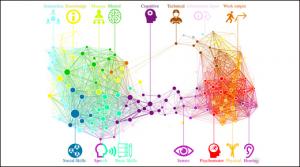All Features

M. Mitchell Waldrop, Knowable Magazine
This story was originally published by Knowable Magazine.
Back in the 1990s, when U.S. banks started installing automated teller machines in a big way, the human tellers who worked in those banks seemed to be facing rapid obsolescence. If machines could hand out cash and accept deposits on their…

Jeffrey Phillips
It finally came to me last week. For more than a decade I’ve been working with corporations, trying to help them accelerate their ability to generate new, interesting ideas to market as viable products and services. In some instances we’ve been successful, and in other instances there were…

Mike Richman
One of the highlights on our calendar each year is the first Friday in October, which is Manufacturing Day here in the United States. This event offers us the perfect opportunity to celebrate the centrality of manufacturing as a driver of the economy, innovation, automation, education, and lots…

Science, technology, engineering and math (STEM) career outreach programs play a pivotal role in shaping the capabilities and makeup of the future workforce. Generally speaking, “STEM outreach” involves organizing events, both in and out of school, where we can encourage and inspire young people to…

Jack Dunigan
Do you know the one thing you can do to light the fire of motivation, energy, creativity, and self-propelled action in your employees?
The discovery of gold in Northern California lit off a tidal wave of prospectors, who came by the thousands to find their share of wealth. A very small number…

Jesse Lyn Stoner
Mary Parker Follett, a pioneering business consultant, was asked to help a troubled window shade company. The company’s thinking was narrow and limited. When asked to define their business, they said, “We produce window shades.”
She asked them “What business are you really in from your customer’s…

Eryn Brown, Knowable Magazine
Alan Colquitt is a student of the ways people act in the workplace. In a corporate career that spanned more than 30 years, the industrial-organizational psychologist advised senior managers and human resources departments about how to manage talent—always striving to “fight the good fight,” he says…

Jennifer V. Miller
Is your organization built on a culture of trust?
Look around you; there are plenty of clues as to whether trust abounds. How quickly are decisions made? How many people do you copy (or worse, bcc) on emails? Do executives check in on the “troops” even when on vacation?
Given that 82 percent of…

Laurel Thoennes @ Quality Digest
Does this sound familiar? The keynote speaker is talking a mile a minute as you scramble to take notes on her every word. Your hand cramps, and then it’s over. Speaker bows to a standing ovation while you sit perturbed, knowing you missed some things. But angst arrives as you look over your notes…

Kevin Meyer
For the past several years, I’ve been fascinated by how we think—and how that affects us, our leadership, and the organizations we’re a part of. A couple years ago I wrote about the beginner’s mind and the various forms of bias, particularly confirmation bias. During the past couple months, I’ve…

Caroline Preston
Editor’s note: This story is part of Map to the Middle Class, a Hechinger Report series looking at the good middle-class jobs of the future and how schools are preparing young people for them.
The program had to be a scam. Why would anyone, she wondered, pay her to go to college?
Even after Sarat…

Morgan Ryan Frank, Iyad Rahwan
How do workers move up the corporate ladder, and how can they maximize their career mobility? Increased wealth disparity, increased job polarization, and decreases in absolute income mobility (i.e., the fraction of children who earn more than their parents) all suggest that upward mobility is…

Jeffrey Phillips
Ihave been thinking a lot lately about innovation and how we may have emphasized one component at the expense of another. Here I’m talking about something that should appear obvious—the focus of innovation in building new things. We are constantly reminded that innovation is about building new…

Tara García Mathewson
Some of the most celebrated education reform efforts today serve to make instruction more difficult. Personalized learning, project-based learning, mastery-based learning—they all require more work of teachers and more work of students.
But several speakers at the LearnLaunch Across Boundaries…

Aiman Sakr
Does your organization benefit from lessons learned? Does it learn from previous quality issues? A vast amount of learning takes place every day in every manufacturing facility. Do global manufacturing companies share experiences gained from resolving quality issues between overseas plants? And…

Eryn Brown, Knowable Magazine
In ancient times, the story goes, cooks in the city of Sybaris were granted yearlong monopolies for the sale of unique dishes they created. Since then, generations of inventors have relied on patents to discourage copycats from stealing their best ideas. Economists, in turn, have tallied up patents…

Dick Wooden
Iran across the book, Successful Human Relations: Principles and practice in business, in the home, in government (Harpercollins, 1952) while browsing older books about relationship development from William J. Reilly, who also wrote The Law of Intelligent Action (Joanna Cotler Books, 1945). His…

Jim Benson
Human beings are good at placing roadblocks to success and building plans that can’t be followed. We tend to fall back on our “common sense” or “snap judgement” which often makes us feel like our cavalier decisions were actually thought out. Yet, time and again, we find ourselves in deadline…

Chip Bell
The 1962 film, Lawrence of Arabia, won the Oscar for Best Picture at the 35th Academy Awards. Given the current conflicts in the Middle East, I recently watched the four-hour movie to learn more about the cultural history of the area.
Thomas Edward Lawrence (played by Peter O’Toole) was a British…

Matthew E. May
Process improvers the world over rally around root cause analysis as if it were the holy grail of all things organizational. But is it?
Understanding the root cause of a problem certainly makes sense in the context of a present day situation carrying the potential for a correct answer or solution…

MIT Sloan School of Management
Traditional corporate hierarchies tend to rely on static design. There’s the CEO at the top, followed by directors and managers. Red tape and inefficient processes can bog down decisions.
Dynamic work design is a more effective method of managing workflow, especially intellectual work, says MIT…

Mark Rosenthal
A couple of weeks ago I posed the question, “Are you overproducing improvements?” and compared a typical improvement “blitz” with a large monument machine that produces in large batches.
I’d like to dive a little deeper into some of the paradoxes and implications of 1:1 flow of anything,…

Kevin Meyer
One of my great pleasures is going for a walk on the six-mile-long and generally empty beach a couple blocks from my house. There’s the remnant of a long-dormant (hopefully!) volcano at one end that is strangely humbling. A long walk in such a beautiful spot creates a connection between nature, my…

Mary Hallock
In lean we talk about “seeing the waste” and using visual tools. Many of us who use these terms have had a lot of training in engineering, manufacturing, and other highly technical areas. However, the skills needed to “see” problems may lie more firmly in the study of art.
I recently read an…

Rob Matheson
Carrying your smartphone around everywhere has become a way of life. In doing so, you produce a surprising amount of data about your role in the economy—where you shop, work, travel, and generally hang out.
Thasos Group, founded at MIT in 2011, has developed a platform that leverages those data,…